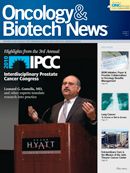Lung Cancer: To Screen or Not to Screen?
Early-stage diagnosis gives patients their best chance against lung cancer. The rush to adopt lung cancer screening seems premature, however, because no randomized trials have definitively demonstrated that it improves survival outcomes. The National Lung Screening Trial (NLST), sponsored by the National Cancer Institute, aims to supply this data, with final results expected in ~1 year.
Annals of Internal Medicine
Early-stage diagnosis gives patients their best chance against lung cancer. The rush to adopt lung cancer screening seems premature, however, because no randomized trials have definitively demonstrated that it improves survival outcomes. The National Lung Screening Trial (NLST), sponsored by the National Cancer Institute, aims to supply this data, with final results expected in ~1 year. In an ominous preview of what the trial might find, the NLST feasibility study, recently published in the , concluded that screening smokers for lung cancer using low-dose computed tomography (CT) scanning and chest radiography produced significant rates of false positives. The authors note that an incorrect screening result has physical, psychological, and economic consequences and warn clinicians to exercise caution in responding to a patient’s request for lung cancer screening.
From September 2000 to January 2001, the multicenter study recruited 3190 current or former smokers, aged 55 to 74 years (Figure). Eligible participants had smoked ≥30 pack-years (packs/day x years smoking) and continued to smoke or had quit within the past 10 years. Ensuring nearly identical age, sex, and smoking characteristics between the two cohorts, investigators randomly assigned individuals to receive low-dose CT scanning (n = 1610) or chest radiography (n = 1580). Patients were screened at baseline. Those with a negative baseline screening were rescreened 1 year later. In patients who underwent CT scanning, noncalcified nodes >3 mm at baseline or >4 mm at year 1 were considered suspicious for cancer. Other abnormalities could lead to a positive finding, at the discretion of a board-certified radiologist. With chest radiography, several signs were considered suggestive of cancer: nodules with circular opacity of ≤3 cm in diameter; masses >3 cm; hilar or mediastinal lymph node enlargement (excepting calcified nodes); major atelectasis; infiltrates or consolidation; and pleural masses. The accuracy of positive results was evaluated in subsequent analyses. After a single screening, the probability of a false-positive result was 21% (95% confidence interval [CI], 19%-23%) for CT scanning and 9% (95% CI, 8%-11%) for conventional chest radiography. With 2 screenings, the cumulative probability of a false positive jumps to 33% (95% CI, 31%-35%) for CT scanning and 15% for chest radiography (95% CI, 13%- 16%). In light of the increased push for lung cancer screening by hospitals, advocacy groups, and even the US Congress through the Lung Cancer Mortality Reduction Act of 2009, which asserts without substantiation that “significant and rapid improvements in lung cancer mortality can be expected through greater use and access to lung cancer screening tests,” these data are alarming.
The authors said it would have been impractical and even harmful to biopsy every patient in whom screening detected abnormalities but was not definitive. Instead, they relied on a complete diagnostic work-up to evaluate a positive result. A false-positive screening was defined as one followed by a negative work-up or no lung cancer diagnosis within 12 months. Though false-positive rates were relatively high, the researchers predicted even greater numbers would have been observed had the screening not been limited to 2 rounds, with 12 months of follow-up after the second screening. They attributed any correlations between patient demographics and falsepositive risk to the modest sample size, small subgroups, and any multiplicity potential of the multivariable analysis. A false-negative test was defined as a negative screening result followed by a lung cancer diagnosis within 12 months.
A primary concern with false positives is the invasive procedures that often ensue, such as unnecessary surgeries or biopsies that can, on rare occasions, lead to a collapsed lung, bleeding, infection, nerve damage, pain, and discomfort. In the subgroup of patients that received false-positive results, 4% who had CT screening and 3% who had chest radiography underwent moderately invasive procedures, with 2% of patients in each cohort having major surgical procedures. Additionally, patients with positive screenings often undergo further imaging studies, increasing their radiation exposure and risk of radiation-induced carcinogenesis. In the trial, 61% (n = 308) of patients in the CT arm and 51% (n = 110) of those in the chest radiography arm who had a false-positive result received additional imaging tests. In some cases, higher doses of radiation were used in conducting follow-up imaging studies than in the initial screening examination.
Beyond potential physical harm, false positives leave patients feeling anxious as they wait for definitive results. For patients, the period of diagnostic uncertainty can last up to 2 years and cost them thousands of dollars for additional testing. The potential psychological damage is unknown, and the increased medical expenditures have not been quantified. Lung cancer researchers hope that the discovery of other diagnostic techniques, such as biomarker tests, will improve the accuracy and feasibility of screening.
Primum non nocere
The enormity of the risks associated with lung cancer screening challenges the guiding principal of medical ethics, , or “First, do no harm.” Physicians are left weighing the current options and awaiting NLST results. In the meantime, the authors say it is important for providers to discuss the benefits and harms of current technologies with patients who request lung cancer screening.
Ann Intern Med.
Croswell JM, Baker SG, Marcus PM, Clapp JD, Kramer BS. Cumulative incidence of false-positive test results in lung cancer screening: a randomized trial. 2010;152(8):505-512,W176-W180.




